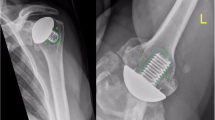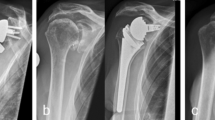Abstract
Introduction
The aim of this study was to evaluate the clinical and radiological outcome of the Total Evolutive Shoulder System (TESS) in patients with cuff tear arthropathy and patients in need of a revision arthroplasty.
Methods
In this sequential study, 67 patients (56 non-stemmed, 11 stemmed) were evaluated after a mean follow-up of 17.5 months. The relative Constant and DASH scores, radiological joint geometry changes, complications and postoperative problems, which are not likely to affect the outcome, were evaluated.
Results
A significant increase was noticed for the relative Constant (11.3 vs. 78.8 %) and DASH scores (73.7 vs. 31.8) without significant differences between both etiology groups. Complication rates were similar to previous studies. An aseptic loosening of the non-stemmed humeral component was not noticed in the cuff tear arthropathy group, whereas one case with a loosening was noticed in the revision arthroplasty group. With nine cases (13.4 %), scapular notching rates were very low. On average, the acromiohumeral distance increased by 17 mm and the humeral offset by 13.9 mm; the height of the center of rotation decreased by 4.6 mm and the lateral glenohumeral offset by 6.1 mm, p < 0.05, respectively.
Conclusion
Regarding the joint geometry, surgery with the TESS system provided adequate distalization and medialization of the humerus and the center of rotation. This corresponds to a good clinical outcome. The use of the surgical opportunity to implant the prosthesis with a relatively low neck–shaft angle might explain the low rates of scapular notching in our series. Regarding the case with a loosening of the humeral component, the surgeon should carefully indicate a stemless version for metaphyseal press-fit fixation in patients with revision arthroplasty.





Similar content being viewed by others
References
Grammont PM, Baulot E (1993) Delta shoulder prosthesis for rotator cuff rupture. Orthopedics 16(1):65–68
Boileau P, Watkinson DJ, Hatzidakis AM, Balg F (2005) Grammont reverse prosthesis: design, rationale, and biomechanics. J Should Elb Surg 14(1):147–161
Kim SH, Wise BL, Zhang Y, Szabo RM (2011) Increasing incidence of shoulder arthroplasty in the United States. J Bone Joint Surg Am 93(24):2249–2254
Constant CR, Murley AH (1987) A clinical method of functional assessment of the shoulder. Clin Orthop Relat Res 214:160–164
Hudak PL, Amadio PC, Bombardier C (1996) Development of an upper extremity outcome measure: the DASH (disabilities of the arm, shoulder and hand) [corrected]. The Upper Extremity Collaborative Group (UECG). Am J Ind Med 29(6):602–608
Sirveaux F, Favard L, Oudet D, Huquet D, Walch G, Mole D (2004) Grammont inverted total shoulder arthroplasty in the treatment of glenohumeral osteoarthritis with massive rupture of the cuff. Results of a multicentre study of 80 shoulders. J Bone Joint Surg Br 86(3):388–395
Thomas SR, Sforza G, Levy O, Copeland SA (2005) Geometrical analysis of Copeland surface replacement shoulder arthroplasty in relation to normal anatomy. J Should Elb Surg 14(2):186–192
Wall B, Nove-Josserand L, O’Connor DP, Edwards TB, Walch G (2007) Reverse total shoulder arthroplasty: a review of results according to etiology. J Bone Joint Surg Am 89(7):1476–1485
Delloye C, Joris D, Colette A, Eudier A, Dubuc JE (2002) Mechanical complications of total shoulder inverted prosthesis. Rev Chir Orthop Reparatrice Appar Mot 88(4):410–414
Melis B, DeFranco M, Lädermann A, Mole D, Favard L, Nerot C, Maynou C, Walch G (2011) An evaluation of the radiological changes around the Grammont reverse geometry shoulder arthroplasty after eight to 12 years. J Bone Joint Surg Am 93(9):1240–1246
Bufquin T, Hersan A, Hubert L, Massin P (2007) Reverse shoulder arthroplasty for the treatment of three- and four-part fractures of the proximal humerus in the elderly: a prospective review of 43 cases with a short-term follow-up. J Bone Joint Surg Br 89(4):516–520
Boileau P, Watkinson D, Hatzidakis AM, Hovorka I (2006) Neer Award 2005: the Grammont reverse shoulder prosthesis: results in cuff tear arthritis, fracture sequelae, and revision arthroplasty. J Should Elb Surg 15(5):527–540
Werner CML, Steinmann PA, Gilbart M, Gerber C (2005) Treatment of painful pseudoparesis due to irreparable rotator cuff dysfunction with the Delta III reverse-ball-and-socket total shoulder prosthesis. J Should Elb Surg 87(7):1476–1486
Wellmann M, Struck M, Pastor MF, Gettmann A, Windhagen H, Smith T (2013) Short and midterm results of reverse shoulder arthroplasty according to the preoperative etiology. Arch Orthop Traum Surg 133(4):463–471
Zumstein MA, Pinedo M, Old J, Boileau P (2011) Problems, complications, reoperations, and revisions in reverse total shoulder arthroplasty: a systematic review. J Should Elb Surg 20(1):146–157
Kadum B, Mukka S, Englund E, Sayed-Noor A, Sjoden G (2014) Clinical and radiological outcome of the Total Evolutive Shoulder System (TESS(R)) reverse shoulder arthroplasty: a prospective comparative non-randomised study. Int Orthop 38(5):1001–1006
Ballas R, Beguin L (2013) Results of a stemless reverse shoulder prosthesis at more than 58 months mean without loosening. J Should Elb Surg 22(9):1–6
Holcomb JO, Cuff D, Petersen SA, Pupello DR, Frankle MA (2009) Revision reverse shoulder arthroplasty for glenoid baseplate failure after primary reverse shoulder arthroplasty. J Should Elb Surg 18(5):717–723
Mizuno N, Denard PJ, Raiss P, Walch G (2012) The clinical and radiographical results of reverse total shoulder arthroplasty with eccentric glenosphere. Int Orthop 36(8):1647–1653
Simovitch RW, Zumstein MA, Lohri E, Helmy N, Gerber C (2007) Predictors of Scapular Notching in Patients Managed with the Delta III Reverse Total Shoulder Replacement. J Bone Joint Surg Am 89(3):588–600
Scarlat MM (2013) Complications with reverse total shoulder arthroplasty and recent evolutions. Int Orthop 37(5):843–851
Simovitch RW, Zumstein MA, Lohri E, Helmy N, Gerber C (2007) Predictors of scapular notching in patients managed with the Delta III reverse total shoulder replacement. J Bone Joint Surg Am 89(3):588–600
Boileau P, O’Shea K, Moineau G, Roussane Y (2011) Bony Increased-Offset Reverse Shoulder Arthroplasty (BIO-RSA) for Cuff Tear Arthropathy. Oper Tech Orthop 21(1):69–78
Edwards TB, Trappey GJ, Riley C, O’Connor DP, Elkousy HA, Gartsman GM (2012) Inferior tilt of the glenoid component does not decrease scapular notching in reverse shoulder arthroplasty: results of a prospective randomized study. J Should Elb Surg 21(5):641–646
De Biase CF, Delcogliano M, Borroni M, Castagna A (2012) Reverse total shoulder arthroplasty: radiological and clinical result using an eccentric glenosphere. Musculoskelet Surg 96(1):27–34
de Wilde LF, Poncet D, Middernacht B, Ekelund A (2010) Prosthetic overhang is the most effective way to prevent scapular conflict in a reverse total shoulder prosthesis. Acta Orthop 81(6):719–726
Roche CP, Marczuk Y, Wright TW, Flurin PH, Grey S, Jones R, Routman HD, Gilot G, Zuckerman JD (2013) Scapular notching and osteophyte formation after reverse shoulder replacement: radiological analysis of implant position in male and female patients. Bone Joint J 95-B(4):530–535
Kempton LB, Balasubramaniam M, Ankerson E, Wiater JM (2011) A radiographic analysis of the effects of prosthesis design on scapular notching following reverse total shoulder arthroplasty. J Should Elb Surg 20(4):571–576
Hamada K, Yamanaka K, Uchiyama Y, Mikasa T, Mikasa M (2011) A radiographic classification of massive rotator cuff tear arthritis. Clin Orthop Relat Res 469(9):2452–2460
Hamada K, Fukuda H, Mikasa M, Kobayashi Y (1990) Roentgenographic findings in massive rotator cuff tears. A long-term observation. Clin Orthop Relat Res 469(254):92–96
Ackland DC, Roshan-Zamir S, Richardson M, Pandy MG (2010) Moment arms of the shoulder musculature after reverse total shoulder arthroplasty. J Bone Joint Surg Am 92(5):1221–1230
Jobin CM, Brown GD, Bahu MJ, Gardner TR, Bigliani LU, Levine WN, Ahmad CS (2012) Reverse total shoulder arthroplasty for cuff tear arthropathy: the clinical effect of deltoid lengthening and center of rotation medialization. J Should Elb Surg 21(10):1269–1277
Rettig O, Maier MW, Gantz S, Raiss P, Zeifang F, Wolf SI (2013) Does the reverse shoulder prosthesis medialize the center of rotation in the glenohumeral joint? Gait Posture 37(1):29–31
Lädermann A, Williams MD, Melis B, Hoffmeyer P, Walch G (2009) Objective evaluation of lengthening in reverse shoulder arthroplasty. J Should Elb Surg 18(4):588–595
Lädermann A, Walch G, Lubbeke A, Drake GN, Melis B, Bacle G, Collin P, Edwards TB, Sirveaux F (2012) Influence of arm lengthening in reverse shoulder arthroplasty. J Should Elb Surg 21(3):336–341
Lädermann A, Edwards TB, Walch G (2014) Arm lengthening after reverse shoulder arthroplasty: a review. Int Orthop 38(5):991–1000
Lädermann A, Lubbeke A, Melis B, Stern R, Christofilopoulos P, Bacle G, Walch G (2011) Prevalence of neurologic lesions after total shoulder arthroplasty. J Bone Joint Surg Am 93(14):1288–1293
Conflict of interest
No author of this manuscript has any financial or non-financial competing interests. No benefits or funds were received in support for the study.
Author information
Authors and Affiliations
Corresponding author
Additional information
M. Manzke, T. J. Filler and J. Jerosch contributed equally to this work.
Rights and permissions
About this article
Cite this article
von Engelhardt, L.V., Manzke, M., Filler, T.J. et al. Short-term results of the reverse Total Evolutive Shoulder System (TESS) in cuff tear arthropathy and revision arthroplasty cases. Arch Orthop Trauma Surg 135, 897–904 (2015). https://doi.org/10.1007/s00402-015-2218-6
Received:
Published:
Issue Date:
DOI: https://doi.org/10.1007/s00402-015-2218-6




